| Lot |
Photo |
Description |
Realized |
Lot 790 |
 |
280 Million Year Old Amphibian With Skin. All fossils of the first amphibians are rare and found in only a few locations in the world. Amphibian fossils that still preserve their skin structure are even rarer. The best preserved amphibians come from a site closed to collecting for over 25 years in the Odernheim Pfatz in Germany. This large 8 inch long amphibian, Sclerocephalus on a 8 x 8.5 matrix is nearly complete with an excellent 3-D skull, two legs with toes (one with three toes and one with four toes) plus two partial rear legs. There are skin impressions covering much of the body which show skin texture and patterns. The matrix has been expertly repaired in three sections but the all important fossil amphibian is not missing any body parts in the repaired crack areas.
Add $25 for domestic shipping.
Estimated Value $750 - 1,000.
View details and enlarged photo
| Unsold |
Lot 791 |
 |
A Cleaned ½" Emerald Found on Private Property in St. Augustine, Florida. Fully ½" across, this fine quality green emerald is safely lodged in its native white quartz as found. The emerald is an astonishing display piece, deep green color with excellent clarity, cleaned away from the stone, but still embedded. Just as this find would have affected a Conquistador in his day, this excites the treasure hunter like nothing else today! Weight: 20.8 oz.
Estimated Value $4,000 - 5,000.
Found on private property in St. Augustine, Florida.
View details and enlarged photo
| Realized
$7,200 |
Lot 792 |
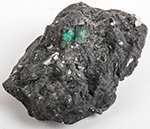 |
An Uncleaned Rock with Two Embedded Emeralds from St. Augustine, Florida. Two startling green emeralds embedded in black volcanic rock as found, uncleaned and in choice condition. This is what the Spanish and European treasure hunters were looking for as they scoured the New World for its treasure. These are valuable not only for their quality, but as treasures from a period when the Americas held such promise of riches and trove for the conquering Europeans. Weight: 4.2 oz.
Estimated Value $2,000 - 3,000.
Found at the St. Augustine Mission Excavation site.
View details and enlarged photo
| Realized
$1,980 |
Lot 793 |
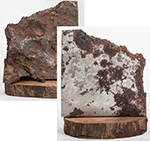 |
Campo del Ciela Iron-Nickel Meteorite. This unusually large 7" x 7" x 1 3/4" section of a Campo del Cielo iron-nickel meteorite has been polished and etched to show its Widmanstatten pattern which in a Campo meteorite resembles a puzzle with the two different alloys of nickel etching out differently. The back side of the meteorite has been left original with large regmaglypts visible. Also, two of the edges are irregular as found on the complete meteorite. There are also a number of dark spots which are Troolite (iron-sulfide). These Troolite inclusions are softer than the iron-nickel matrix and melt off as the meteorite passes through the atmosphere if on the surface of the meteorite creating Regmaghypts (thumbprints). At 10 1/2 pounds this is one of the largest polished and etched sections available. Melt sections are less than one pound. A tree section wooden base is included to mount the meteorite for display.
Estimated Value $500 - 600.
View details and enlarged photo
| Unsold |
Lot 794 |
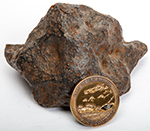 |
Campo del Cielo Meteorite. Ten pound meteor from Campo del Cielo, Argentina, found in 1576 by Spanish explorers in Gran Chaco; 2" commemorative gold coin included.
Estimated Value $800 - 1,000.
View details and enlarged photo
| Realized
$1,080 |
Lot 795 |
 |
Canyon Diablo Meteorites. Three coarse octahedrite meteorites from Arizona; varying sizes, 41gm, 453gm, 519 gm for a total weight of 1033gm; smallest size has a drill hole; some natural rust.
Estimated Value $350 - 500.
View details and enlarged photo
| Realized
$288 |
Lot 796 |
 |
Carbonaceous Meteorite With Stardust. Carbonaceous meteorites are stony meteorites that contain chondrites (spherical shaped minerals that formed from the cloud of dust that formed our solar system. They are high in carbon and contain organic compounds including amino acids which are the building blocks of life. Just recently, nucleobases which are small molecules found in DNA and RNA have been found in pristine Antarctica carbonaceous meteorites. Some of the necleobases found are very rare in Earth biology.
NWA 6368 aCV3 carbonaceous meteorite was found in the Sahara desert of Morocco in 2009 consisting of hundreds of mostly small fragments weighing slightly less than 6 kg total. This 1.75 x .9 inch 8.24 gram full slice has been polished on both sides revealing many multi-colored different sized chondrites as well as several white Calcium Aluminum inclusions including one large piece on its edge. CAI's are thought to be the very first compounds that solidified out of the gases of the SuperNovae that preceded the formation of our Solar System, real stardust. These CAI's are therefore older than any other materials such as rocks that formed with our Solar System. In a 4.25 x 3.25 inch Riker Mount.
Add $10 for domestic shipping.
Estimated Value $300 - 400.
View details and enlarged photo
| Realized
$216 |
Lot 797 |
 |
Carbonado - A Black Diamond From Space. The rarest and hardest diamonds on earth come from outer space. Carbonados, dark and uncrystalized diamonds do not look like any other diamonds on earth because they were created by an exploding star before the formation of our solar system and delivered to Earth by an asteroid over two billion years ago. These rare diamonds are only found on the east coast of Brazil and the west coast of the Central African Republic which were joined together at the time of the meteorite impact over two billion years ago. Because of the lack of crystal structure there are no shear planes in which to facet these fascinating black diamonds. (the color can vary from black to dark grey and dark green depending on their trace elements). The proof of an extraterrestrial origin is the presence of nitrogen and hydrogen in their matrix. The presence of hydrogen in Carbonados indicates that an origin in a hydrogen-rich interstellar space and formed from a supernova explosion of a star several times larger than our sun. Carbonados are never found in any diamond mines anywhere else in the world which is consistent with their origin from a single asteroid impact over two billion years ago with all other traces of the meteorite long weathered away with only the few small black diamonds remaining.
Most Carbonado black diamonds recovered have been small weighing 3 carats or less. This large 22mm x 15mm, 24.38 carat lustrous charcoal grey stone is certainly the exception. It is completely original with a microscopic pebbly appearance of the individual diamond crystals being compressed together within the star during formation and is both beautiful and rare being older than any other rocks or diamonds found on earth (older than 4.56 billion years)
Add $20 for domestic shipping.
Estimated Value $1,300 - 1,700.
View details and enlarged photo
| Unsold |
Lot 798 |
 |
Large NWA 869 Stony Meteorite. Most stony meteorites are small because the larger stony meteorites usually break apart or explode before they contact the earth. This large 4 x 2.5 x 2 inch 812 gram nearly two pound complete stony is one of the exceptions. It is designated as an NWA 869 meteorite meaning that it was the 869th meteorite from North West Africa to be classified by a meteorite institute. It is an ordinary chondrite (L4-6) breccia which means that it consists of primarily L-type chondrite (low iron) but also contains fragments of achondritic and carbonaceous meteorites that impacted the L parent body in the asteroid belt many millions of years ago causing NWA meteorites to be blasted into space and eventually fall to earth. All ordinary stony meteorites contain iron from the original gas cloud from which the solar system was created. This meteorite is completely original just as found in the desert with nearly complete dark brown fusion crust. Fusion crust is the thin dark brown layer that forms from the high heat when the meteorite passes through the earth's atmosphere. This museum quality NWA 869 meteorite is one of the finest NWA 869 meteorites recovered as most of them have little original fusion. Comes with a 4 inch Illusion stand for display.
Add $20 for domestic shipping.
Estimated Value $550 - 700.
View details and enlarged photo
| Unsold |
Lot 799 |
 |
Lunar Meteorite Dhofar 1084. This nice size .302 gram 12mmX7mm thin section of the moon meteorite Dhofar 1084 is housed in a special membrane box for visibility on all sides. Lunar meteorites are the most desirable and expensive of all the types of meteorites recovered and are even rarer than meteorites from Mars. For some reason, all of the recovered lunar meteorites except one are small and Dhofar 1084 is one of the smaller Lunar meteorites weighing only 90 grams found in the Dhofar region of the Oman desert in 2003. It has been classified as a Lunar feldspathic basalt-bearing regolith breccia from the Lunar highlands which means that it is a mixture of several different types of moon rocks rich in Feldspar. The Lunar highlands are the features on the moon that appear to be bright when viewed from the Earth but are actually heavily cratered areas. These basaltic Lunar rocks were melted and partially mixed together when a large meteorite crashed into the moon millions of years ago. This rock mixture was vaporized and ejected from the moon and eventually made its way to the earth. This section is has a dark gray matrix with various shaped white inclusions. This very valuable meteorite is large enough to be held in ones hand and is housed in a clear membrane box and a 5.5 x 4.5 inch Riker box and an authenticity card from the Hupe Collection.
Add $15 for domestic shipping.
Estimated Value $600 - 900.
View details and enlarged photo
| Realized
$720 |
Lot 800 |
 |
Meteorite Admire Pallasite. Pallasites are the rare type of meteorites that came from the core-mantle boundary of a very large asteroid that was destroyed by impact early in the formation of our solar system. It is a stony-iron with a iron-nickel matrix interspersed with olivine crystals. The Admire Pallasite was first discovered near Admire Kansas in 1881 even though it fell to earth some 15,000 years ago.
This large section is 6.23 x 3.75 inches and 0.3 cm thick weighing a hefty 232.3 grams and is loaded with olivine crystals with about 50 percent of the surface covered in olivine with the rest being iron-nickel. More than two dozen of the olivine crystals are translucent with some approaching gem quality. The color of the crystals varies from yellow- green to a deep peridot green color. One of the olivine crystals is very large 13mm and has a nice clear peridot green color. The Admire Pallasite is one of the most beautiful of all known pallasites and is unique in pallasites in that some of the olivine crystals have a characteristic called chatoyancy. Chatoyancy is defined as the change of luster within a gemstone due to the way the crystals reflect light. This rare occurrence is caused by tiny void tubes which appear like the effect of fiber optics when the gemstone is cut parallel to the tubes. This effect can be observed in some of olivine crystals of the Admire Pallasite when viewed in low light as the crystals seem to turn on and off by themselves. Comes with a 4 inch Illusion stand for display.
Add $20 for domestic shipping.
Estimated Value $1,300 - 1,800.
View details and enlarged photo
| Realized
$1,260 |
Lot 801 |
 |
Meteorite Campo del Cielo Etched. The famous iron-nickel meteorite Campo del Cielo fell to the earth over 4,000 years ago in mountainous region of Gran Chaco, Argentina, 500 miles north-northwest of Buenos Aries, in one of the largest and undoubtedly most dramatic falls in the last 10,000 years. Meteorites from this fall were scattered over hundreds of square miles of inaccessible terrain. This heavy 7 x 5 x 3 inch meteorite weighs 13.5 pounds and has been cut in half, polished and etched on both halves to show its Widmanstatten pattern which results from two alloys of Nickel in the meteorite etching at different rates. There are no iron-nickel rocks on Earth that exibit a Widmanstatten pattern because the parent asteroid where these iron-nickel meteorites originate was destroyed by impact with another large asteroid and the new melted iron-nickel core had to cool at the very slow rate of a couple of degrees per million years to allow enough time for the nickel alloys Kamacite (the light bands which are low in nickel) and Taenite (the dark bands which are high in nickel) to separate. This complete meteorite has its original surface with regmaglypts and fusion crust all around and has its interior beautifully etched to show the coarse octahedrite pattern of this Type 1A iron-nickel meteorite.
Add $30 for domestic shipping.
Estimated Value $600 - 900.
View details and enlarged photo
| Realized
$456 |
Lot 802 |
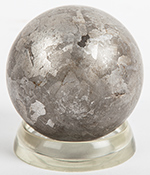 |
Meteorite Campo del Cielo Sphere. The famous iron-nickel meteorite Campo del Cielo fell to the earth over 4,000 years ago in mountainous region of Gran Chaco, Argentina, 500 miles north-northwest of Buenos Aries, in one of the largest and undoubtedly most dramatic falls in the last 10,000 years. Meteorites from this fall were scattered over hundreds of square miles of inaccessible terrain. This 1.6 inch diameter 475 gram sphere (over one pound) has been polished and etched to show its Widmanstatten pattern which results from two alloys of Nickel in the meteorite etching at different rates. There are no iron-nickel rocks on Earth that exibit a Widmanstatten pattern because the parent asteroid where these iron-nickel meteorites originate was destroyed by impact with another large asteroid and the iron-nickel core had to cool at the very slow rate of a couple of degrees per million years to allow enough time for the nickel alloys Kamacite and Taenite to separate.
Add $15 for domestic shipping.
Estimated Value $275 - 400.
View details and enlarged photo
| Realized
$324 |
Lot 803 |
 |
Meteorite Etched Gibeon. Gibeon iron-nickel meteorites are in very high demand as they are hard to find and possess the most beautiful internal crystalline structure when cut and etched. Gibeon meteorites were found in the Kalahari desert of Namibia, Africa from a fall the occurred thousands of years ago. This 2.75 x 1.8 inch 415 gram (nearly one pound) section has been polished and etched on its interior and all four sides exhibiting the extremely detailed beautiful fine octahedral Widmanstatten pattern as well as a natural back end with its original surface and fusion crust. The interesting geometric pattern resulted from the separation of two alloys of nickel, taenite and kamicite that occurred on the large parent asteroid before it was blown apart early in the formation of the solar system. This crystalline pattern does not exist on any rocks on earth and only forms when the iron core of the asteroid cools very slowly at no more than a few degrees Celsius per million years. Gibeon is considered to have the finest looking regmaglypts because they are so fine, forming a beautiful delicate pattern unlike the coarse Octohedrite irons such as Campo and Canyon Diablo. Displayed on a 2 inch magnetic stand.
Add $15 for domstic shipping.
Estimated Value $750 - 1,000.
View details and enlarged photo
| Unsold |
Lot 804 |
 |
Meteorite From The Biggest Meteor Strike Since 1907. At 9:20 A.M. on the morning of February 15, 2013 a large 8-10 ton 50 foot long meteor exploded 10-15 miles above the ancient city of Chelyabinsk, Russia with the force of over 500,000 tons of TNT, 10 times the force of the atomic bomb that destroyed Hiroshima in 1945. More than 1,500 people were injured from flying glass and debris from the resulting shock wave. This was the largest meteor event in the last 100 years since a large meteor exploded over a remote area of Siberia in 1907. The official name of this meteorite is Chelyabinsk where most of the injuries occurred but most of the meteorite specimens were found on the frozen surface of Chebarkul Lake which is a frozen fresh water lake that is located directly in the meteorite strewnfield about 50 miles west of the city of Chelyabinsk. It is both on this snow covered lake and the surrounding forest where most of the pieces of the stony chondrite LL5 SR4 meteorite were recovered. Because of the immense explosion and ablation through Earth's atmosphere, most of the meteor was either burned up or blasted into a fine powder. More than 95% of the recovered meteorites are extremely small, less than 3 grams in weight.
This beautiful fresh 33 x 25 mm complete specimen weighs 21.9 grams which is much larger than the vast majority recovered. It has a fresh dark brown fusion crust covering more than 75% of the meteorite with the bottom side offering a window inside of the meteorite showing its light gray matrix mixed with specks of iron and rust orange chondrules. This stony chondrite is designated as LL5 SR4 meaning that it is of low iron even for a stony meteorite with the total iron content to be about 10 percent. It is not possible to obtain a fresher meteorite and it is very valuable for study in that there has been no contamination with Earth rocks and erosion. Comes housed in a 8 x 6 inch Riker mount with a photo of the explosion.
Add $15 for domestic shipping.
Estimated Value $800 - 1,000.
View details and enlarged photo
| Realized
$504 |
Lot 805 |
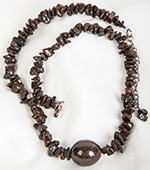 |
Meteorite Necklace Jewelry. This 18 inch long necklace with 2 inch long sterling silver extension is made up of over 90 individual chips from the stony meteorite NWA 869 and has a 15mm long polished oblong NWA 869 meteorite bead in the center. The large meteorite bead has been polished to show the individual chondrites and flecks of iron in its matrix. Comes with a certificate of authenticity. This unusual necklace is made up of a meteorite that formed when the solar system was created 4.57 billion years ago making the stony meteorite pieces older than any rocks on earth.
Add $15 for domestic shipping.
Estimated Value $375 - 475.
View details and enlarged photo
| Realized
$252 |
Lot 806 |
 |
Muonionalusta Meteorite Dagger. This beautiful 10 inch long meteorite dagger has a 6 inch long x 1.1 inch wide etched Iron-Nickel meteorite blade and a 4 inch long Cholla Cactus handle. The meteorite slice is from Muonionalusta, an iron-nickel meteorite that was found in Norrbotten, Sweden in 1906 and since then additional meteorites have been found in one of the largest strewnfields on earth at 30 x 10 kilometers. Muonionalusta is classified as a fine octahedrite and has one of the most beautiful Widmanstatten patterns when it is etched. Widmanstatten patterns form when the two alloys of nickel Kamacite and Taenite separate in the iron core of the large asteroid that was destroyed by collision with another large asteroid in the asteroid belt billions of years ago. The beautiful Muonionalusta Widmanstatten pattern is very similar to the pattern found on the Gibeon meteorite which is probably from the same parent asteroid body.
Add $20 for domestic shipping.
Estimated Value $700 - 1,200.
View details and enlarged photo
| Realized
$1,860 |
Lot 807 |
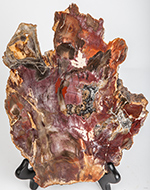 |
Petrified Rainbow Colored Wood. This large 10.5 x 8 inch agatized and polished complete section of petrified wood from the Araucarioxylon tree of Ambilobe Madagascar has a wonderful mix of rainbow colors that resulted from many different minerals permeating the wood at different times from the volcanic soil over millions of years. For example the vibrant red and purple colors were produced by replacement by iron oxide with the black being from manganese. This exceptional irregular large leaf shaped complete section has the most colors imaginable on one fossilized tree with reds, purples, hues of browns, beiges, black and even some clear colored quartz. It looks as if it was painted by an artist. The Araucarioxylon fossilized wood is also found in Arizona but rainbow colored wood is much rarer from Madagascar as most of the Madagascar wood is a boring beige in color.
Add $25 for domestic shipping.
Estimated Value $500 - 700.
View details and enlarged photo
| Realized
$312 |
Lot 808 |
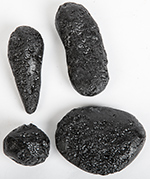 |
Set Of Four Major Shapes Of Indochinite Tektites. Tektites are glass-like objects that formed when a very large meteorite impacted the earth vaporizing itself and melting earth rocks to over 2000 degrees F. The meteorite was most likely a part of a stony asteroid or part of a comet as it was completely vaporized in an enormous explosion high in earth's atmosphere. Unlike meteorites, Tektites are only found in certain parts of the world sometimes near a meteorite crater and sometimes not. The black Indochinites are found mostly in and around Thailand and are a glossy black color made up of mostly amorphous silica somewhat resembling obsidian. They have been dated to be about 800,000 years old which would be the date of the impact when they formed out of the molten earth and meteorite. The impact crater has not been located but might possibly be somewhere in the Gulf of Tonkin. The tektites get their shape depending on the speed of rotation of the molten rock as it quickly cools after being ejected high into the earth's atmosphere. As the molten rock solidifies into small objects, if there is no rotation it will form a sphere, a slow rotation will form a flattened disc, fast rotation will form a rod or dumbell shape and a very fast rotation will form a teardrop shape.
This lot contains four sizeable specimens of each of the four shapes. 1. a 2 x 2 inch sphere weighing 109grams. 2. a 3 x 2.5 inch flattened disc weighing 138 grams. 3. a 4 x 1.25 inch dumbbell weighing 121 grams and 4. a 3 x 1 inch teardrop weighing 52 grams. These specimens are larger than most found tektites and all have excellent character with craters and pits that occurred when air escaped as they quickly cooled in the atmosphere. Contained in a 8 x 6 inch Riker mount.
Add $15 for domestic shipping.
Estimated Value $250 - 350.
View details and enlarged photo
| Unsold |
Lot 809 |
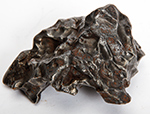 |
Sikhote-Alin Meteorite. Regmaglypts are thumb-print like impressions made when the meteorite heated up and passed thru the earth's atmosphere; fell on February 12, 1947 in Siberia; 430gm.
Estimated Value $550 - 700.
View details and enlarged photo
| Realized
$384 |
Lot 810 |
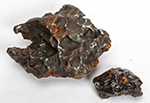 |
Sikhote-Alin Meteorites. Two Iron-Nickel meteorites; Russia; Shrapnel type, that resulted from the explosion of the parent meteorite in the atmosphere approximately 8-12 miles up; smallest 55gm has been holed for jewelry; largest is 416gm with sharp edge. Some regmaglypts. Some rust present.
Estimated Value $275 - 375.
View details and enlarged photo
| Realized
$324 |
Lot 811 |
 |
Tiger Eye Sphere. Tiger Iron is a magnetic mineral that formed between 543 and 2.5 billion years ago. Tiger iron consists of part Jaspar, hematite and Tiger eye. It was formed over thousands of years by mats of microbes living on the seafloor. As these slimy mats of Cyanobacteria died thin layers of minerals built up as new layers of living microbes replaced the old colony. These fossils of colonies of Cyanobacteria are know as stromatolites and are the very first large detectible evidence of life on our planet. This large 3.45 inch diameter magnetic sphere weighs 2.7 pounds and has been polished revealing bands of red and burnt orange Jasper, dark brown hematite and beautiful iridescent yellow Tiger's eye. Tiger's eye is a chatoyant silicon dioxide mineral that gets its color from iron oxide. This gem quality Tiger's eye comes from the Pilbara region of Western Australia. This beautiful sphere comes with a plastic stand for display.
Add $15 for domestic shipping.
Estimated Value $475 - 600.
View details and enlarged photo
| Realized
$690 |
Lot 812 |
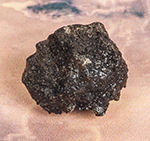 |
Tissint Martian Meteorite. At about 2 A.M. on July 18, 2011 a bright fireball was observed by several people in the Oued Dran Valley east of Tata, Morocco. The intense fireball was at first yellow in color and then turned green before breaking into several pieces resulting in two sonic booms. The first pristine meteorites were found in October 48 km SSW of Tissint Village. Any meteorite recovered from an observed fall becomes highly sought after and highly valued but Tissint was not just any meteorite, it turned out to be a very rare meteorite that originated on the planet Mars. This meteorite was identified as being from Mars by analyzing its oxygen isotopes. The composition of the oxygen isotopes from Mars is different from the composition of the oxygen isotopes from Earth and just like a fingerprint identifies this meteorite as being from Mars.
Because this meteorite is so fresh and was recovered within weeks of its fall in an arid desert, it has tremendous potential for scientists to analyze it to determine the conditions on Mars at the time it was formed and even possibly to find organic matter that might indicate the presence of life. In April 2012, a team of scientists at the Buckingham Center for Astrobiology and Cardiff University led by Professor Chandra Wickramasinghe and PhD student Jamie Wallis have indeed found what they claim to be signs of fossilized life in the Tissint meteorite. Using a powerful electron microscope they found tiny egg-shaped carbon rich globules from the interior of one of the Tissint Martian meteorites. Jamie Wallis believes that these organic spheres are proof of fossil life on Mars 400-500 million years age and are probably remnants of polysaccharide shells surrounding algal type cells. Other scientists are currently trying to confirm these findings. Bubbles within the meteorite could still contain traces of the Martian atmosphere. The glossy black fusion crust looks like glass being so fresh and the interior is a pale gray color with some pale yellow olivine macrocrysts. The host rock solidified out of Martian magma 400-500 million years age and was blasted off the surface of Mars by an asteroid impact around one million years ago.
The largest 2.4 pound Tissint meteorite was purchased by the British Museum for over one million dollars and is considered to be the most important meteorite in their collection and the most important meteorite fall in over 100 years.
This superb quality specimen measures 9 x 7 mm and weighs 0.536 grams, with more than 60% pristine glassy black fusion crust and a view inside the meteorite from the other exposed areas. Presented in a 8 x 5.5 inch Riker mount with a picture of the egg globule. The only way to get a fresher piece of the planet Mars would be to go there and pick one up
Add $15 for domestic shipping.
Estimated Value $750 - 1,000.
View details and enlarged photo
| Realized
$630 |